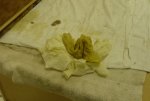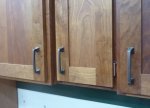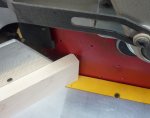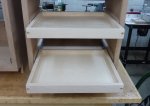Gary Zimmel
Member
- Messages
- 356
- Location
- Stony Plain, Alberta
A Little Color..
Well we are starting to see what these things are going to look like...
But before the BLO we need a little sanding.
I really like my Festool set up. Makes for no dust in the air.

No shop is complete with out some high tec jigs.
Here's one of mine.
A chunk of peg board that has been converted to a shelf pin jig.


And finally a pic of these starting to come to life.
No big finishing secret here.
BLO cut with 1/3 turpentine.. Quick and easy.
Slop it on and wipe off the excess.

And the most important thing I did tonight.
Get rid of the oily rags! Off to my burn barrel outside.
I've seen what these can do if they decide to spontaneously combust.

Things are moving along quite nicely.
This weekend I hope I get some good shop time.
.
Well we are starting to see what these things are going to look like...
But before the BLO we need a little sanding.
I really like my Festool set up. Makes for no dust in the air.

No shop is complete with out some high tec jigs.
Here's one of mine.
A chunk of peg board that has been converted to a shelf pin jig.


And finally a pic of these starting to come to life.
No big finishing secret here.
BLO cut with 1/3 turpentine.. Quick and easy.
Slop it on and wipe off the excess.

And the most important thing I did tonight.
Get rid of the oily rags! Off to my burn barrel outside.
I've seen what these can do if they decide to spontaneously combust.

Things are moving along quite nicely.
This weekend I hope I get some good shop time.
.













 .
.


















